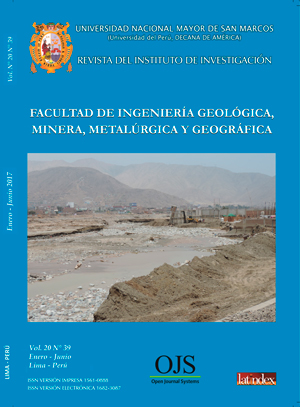Use of calcium carbide for gold recovery from arsenic refractory minerals
DOI:
https://doi.org/10.15381/iigeo.v20i39.14166Keywords:
arsenopyrite, lixiviation, bacterial oxidation, roasting oxidation, cianurationAbstract
The arsenopyrite, FeAsS, it is a mineral that is commonly found associated with gold. In this kind of mineral, Gold is presented in sub-microscopic size particles, encapsulated in a matrix of the same mineral or forming a solid solution, this does not allow the recovery of gold with the available lixiviation techniques. Moreover, a fine grinding does not a chive to break the matrix in which the gold is located, not allowing the lixiviation solutions to come in. Some alternatives that lead to the recovery of gold from those minerals include chemical oxidation, oxidation under pressure, bacterial oxidation and roasting oxidation (which is very polluting due to the emission of As2O3 y SO2 gases. The aim of the following study is to identify the conditions to break the arsenopyrite matrix for continuing the usual process of cianuration. For doing so, experiments were carried out containing arsenopyrite with gold contents.
Downloads
Published
Issue
Section
License
Copyright (c) 2017 Manuel Shishido Sanchez, Edmundo Alfaro Delgado, Adolfo Pillihuaman Zambrano

This work is licensed under a Creative Commons Attribution-NonCommercial-ShareAlike 4.0 International License.
AUTHORS RETAIN THEIR RIGHTS:
a. Authors retain their trade mark rights and patent, and also on any process or procedure described in the article.
b. Authors retain their right to share, copy, distribute, perform and publicly communicate their article (eg, to place their article in an institutional repository or publish it in a book), with an acknowledgment of its initial publication in the Rev. Inst. investig. Fac. minas metal cienc. geogr.
c. Authors retain theirs right to make a subsequent publication of their work, to use the article or any part thereof (eg a compilation of his papers, lecture notes, thesis, or a book), always indicating the source of publication (the originator of the work, journal, volume, number and date).






